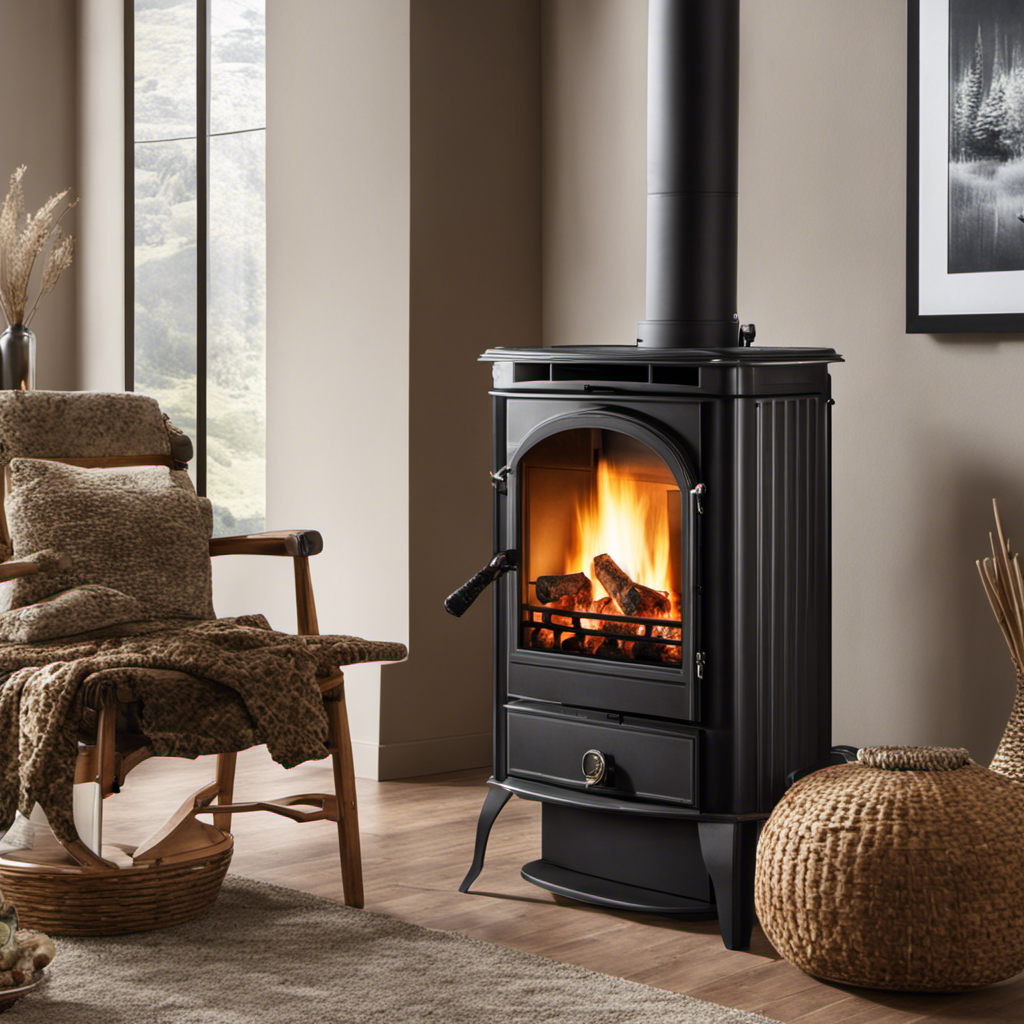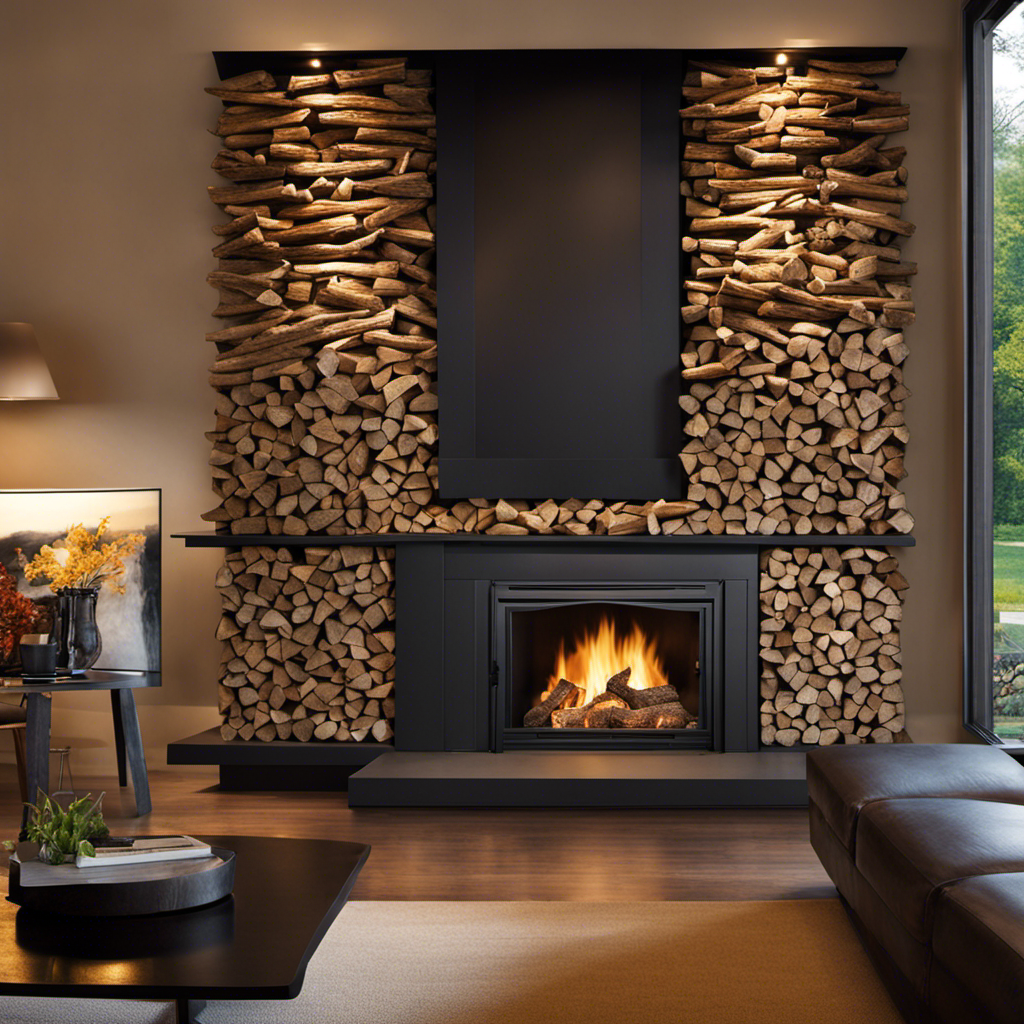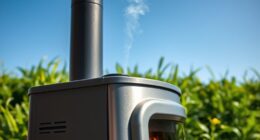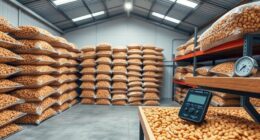Hi there!
I’m here to share some tips and tricks on how to use a wood pellet furnace. Trust me, once you get the hang of it, you’ll be cozy and warm all winter long.
In this informative article, we’ll cover everything from choosing the right furnace to adjusting the temperature and troubleshooting common issues.
So, let’s dive in and make sure you’re getting the most out of your wood pellet furnace!
Key Takeaways
- Consider factors such as size, efficiency, and cost when choosing a wood pellet furnace
- Proper installation and maintenance are crucial for safety and optimal performance
- Store wood pellets properly to maintain their quality and prevent moisture absorption
- Regularly check and adjust thermostat settings for consistent temperature and troubleshoot common issues for optimal furnace performance
Choosing the Right Wood Pellet Furnace
When choosing the right wood pellet furnace, you’ll want to consider factors such as size, efficiency, and cost. Wood pellet furnaces are a great alternative to traditional heating systems, offering numerous benefits.
One of the main advantages is the lower cost of fuel compared to oil or gas furnaces. Wood pellets are also a renewable energy source, making them more environmentally friendly.
Additionally, wood pellet furnaces require regular maintenance to ensure optimal performance. This includes cleaning the burn pot and ash pan, as well as inspecting and replacing the gaskets and seals. By properly maintaining your wood pellet furnace, you can extend its lifespan and maximize its efficiency.
Understanding the basic components of a wood pellet furnace is crucial in effectively operating and maintaining the system.
Understanding the Basic Components of a Wood Pellet Furnace
The basic components of a wood pellet furnace include an auger, a hopper, and a combustion chamber. These components work together to efficiently heat your home.
The auger is responsible for transporting the wood pellets from the hopper to the combustion chamber. The hopper stores the pellets and ensures a steady supply of fuel. The combustion chamber is where the pellets are burned, creating heat that is distributed throughout your home.
When choosing the right furnace size, it’s important to consider the square footage of your home and your heating needs. A properly sized furnace will ensure optimal efficiency and comfort.
There are many benefits of using a wood pellet furnace, including cost savings, reduced carbon emissions, and the use of a renewable energy source.
Moving on to the proper installation of a wood pellet furnace, it is crucial to ensure that all safety guidelines are followed to guarantee safe and effective operation.
Proper Installation of a Wood Pellet Furnace
To ensure a safe and effective installation, make sure you follow all the recommended safety guidelines. Installing a wood pellet furnace requires careful planning and attention to detail. Here are some installation tips and safety precautions to consider:
| Installation Tips | Safety Precautions |
|---|---|
| Choose a suitable location for the furnace, away from combustible materials. | Ensure proper ventilation to prevent carbon monoxide buildup. |
| Follow the manufacturer’s instructions for connecting the furnace to the chimney. | Use proper insulation to prevent heat loss and maximize efficiency. |
| Install a backflow preventer and pressure relief valve to protect the furnace and your home. | Hire a professional if you’re unsure about any aspect of the installation. |
| Connect the furnace to a reliable power source and install a smoke detector nearby. | Keep a fire extinguisher on hand in case of emergencies. |
| Test the furnace thoroughly before regular use to ensure it’s functioning properly. | Regularly inspect and clean the furnace to prevent any potential hazards. |
Loading and Storing Wood Pellets for Your Furnace
When it comes to properly storing wood pellets for your furnace, there are a few key points to keep in mind.
First, it is important to store your pellets in a dry and cool area to prevent moisture absorption and degradation.
Second, using airtight containers or bags can help maintain the quality of the pellets and prevent them from becoming damaged or contaminated.
Lastly, when it comes to loading the pellets into your furnace, using techniques that promote efficiency can help ensure a consistent and reliable heat source for your home.
Proper Pellet Storage
Storing wood pellets properly is essential to ensure their quality and efficiency. When it comes to pellet storage techniques, there are a few key factors to consider in order to prevent moisture damage.
-
Keep pellets in a dry area: Moisture is the enemy of wood pellets, causing them to degrade and lose their energy efficiency. Store them in a dry place, such as a shed or garage, away from dampness and humidity.
-
Use airtight containers: To further protect the pellets from moisture, consider using sealed containers or plastic bags to keep out any potential moisture from the environment.
-
Silica gel packs: Place silica gel packs in the storage containers to absorb any moisture that may accumulate over time.
By following these pellet storage techniques, you can ensure that your wood pellets remain in optimal condition.
Now, let’s move on to loading techniques for efficiency without missing a beat.
Loading Techniques for Efficiency
Loading techniques for efficiency can greatly impact the performance of your furnace. Proper fuel management is essential to ensure optimal heating and to maximize the lifespan of your wood pellet furnace. When loading your furnace, it’s important to follow efficient loading techniques to ensure even combustion and consistent heat output. Here are some tips to help you load your furnace effectively:
| Efficient Loading Techniques | Proper Fuel Management |
|---|---|
| Distribute pellets evenly | Store pellets properly |
| Avoid overloading | Use high-quality fuel |
| Clean the loading area | Avoid moisture in fuel |
| Regularly check ash buildup | Monitor fuel levels |
Adjusting and Maintaining the Temperature of Your Wood Pellet Furnace
To keep the temperature consistent in your wood pellet furnace, you’ll want to regularly check and adjust the settings on the thermostat. Here are some tips for adjusting the temperature and troubleshooting common issues with your wood pellet furnace:
-
Adjusting Temperature:
-
Start by setting the thermostat to your desired temperature.
-
Monitor the furnace to ensure it reaches and maintains the set temperature.
-
If the temperature is too high, lower the thermostat setting.
-
If the temperature is too low, increase the thermostat setting.
-
Troubleshooting Furnace:
-
Check the power supply to ensure the furnace is receiving electricity.
-
Inspect the fuel supply to make sure there are enough pellets.
-
Clean the air intake and exhaust vents to ensure proper airflow.
-
Examine the igniter and the combustion chamber for any signs of damage or blockage.
Cleaning and Troubleshooting Tips for Wood Pellet Furnaces
When it comes to maintaining and troubleshooting wood pellet furnaces, there are a few key points to keep in mind.
First and foremost, proper cleaning techniques are essential to ensure optimal performance. From removing ash buildup to cleaning the exhaust vent, understanding the right way to clean your furnace will help extend its lifespan.
Additionally, being aware of common troubleshooting problems such as ignition issues or pellet feed blockages can save you time and money in the long run.
Lastly, implementing maintenance tips and tricks such as regular inspections and lubrication can help prevent potential problems and keep your wood pellet furnace running smoothly.
Proper Cleaning Techniques
Cleaning the wood pellet furnace regularly is essential for proper maintenance and efficient operation. Here are some proper cleaning techniques to keep your furnace in top shape:
-
Gather the necessary cleaning tools:
-
Soft bristle brush
-
Vacuum cleaner with brush attachment
-
Ash vacuum (if applicable)
-
Dust mask and gloves for protection
-
Clean the burn pot and ash pan:
-
Remove any residual ash using the soft bristle brush and vacuum cleaner.
-
Empty the ash pan and dispose of the ash properly.
It is recommended to clean the burn pot and ash pan at least once a week to prevent clogs and ensure optimal performance. Additionally, check the venting system and heat exchanger for any debris buildup and clean as necessary.
By following these cleaning techniques and maintaining a regular cleaning schedule, you can ensure that your wood pellet furnace operates efficiently and effectively.
Now, let’s move on to common troubleshooting problems that you may encounter with your wood pellet furnace.
Common Troubleshooting Problems
If you experience any issues with your wood pellet furnace, here are some common troubleshooting problems you may encounter.
One common issue is a lack of heat production. This could be due to a clogged air intake or exhaust vent, a malfunctioning auger, or a faulty igniter. To troubleshoot this problem, check for any blockages in the vents and clean them if necessary.
Another common problem is poor pellet combustion, resulting in excessive smoke or soot. This could be caused by a dirty burn pot or improper air-to-fuel ratio. To address this issue, clean the burn pot and adjust the air intake to achieve optimal combustion.
Other issues you may face include pellet jams, ignition failures, or power supply problems. By familiarizing yourself with these troubleshooting techniques, you can quickly resolve common issues and keep your wood pellet furnace running smoothly.
Now, let’s move on to some maintenance tips and tricks to ensure the longevity of your wood pellet furnace.
Maintenance Tips and Tricks
To keep your wood pellet furnace in good condition, it’s important to regularly clean and inspect the components. Here are some maintenance tips and tricks to help you maintain the efficiency and longevity of your furnace:
-
Maintenance Schedule
-
Clean the ash pan and remove any debris regularly.
-
Check and clean the exhaust vent to ensure proper airflow.
-
Troubleshooting Techniques
-
If the furnace does not start, check if the power supply is working.
-
If there are issues with the ignition, check the fuel supply and the condition of the igniter.
By following a regular maintenance schedule and utilizing troubleshooting techniques, you can ensure that your wood pellet furnace operates smoothly.
Now, let’s explore how to maximize efficiency and cost savings with your wood pellet furnace.
Maximizing Efficiency and Cost Savings With Your Wood Pellet Furnace
One of the ways you can maximize efficiency and cost savings with your wood pellet furnace is by properly maintaining and cleaning the system on a regular basis. By doing so, you can ensure that your furnace is operating at its peak performance and that it is utilizing the pellets to their fullest potential.
To maximize energy output, it is important to optimize pellet combustion. This means ensuring that the pellets are being burned efficiently and completely, without any waste. Regularly cleaning the burn pot, ash pan, and vents can help prevent buildup and improve combustion. Additionally, checking and adjusting the air intake and exhaust settings can also help optimize pellet combustion and improve efficiency.
Taking these maintenance steps will not only save you money on fuel costs but also extend the lifespan of your wood pellet furnace.
Can the Uuni Wood Pellet Burner Kit be used in a traditional wood pellet furnace?
Yes, the Uuni wood pellet burner kit can be used in a traditional wood pellet furnace. The kit is designed to be compatible with different types of wood pellet furnaces, making it a versatile option for those looking to upgrade their existing systems.
Frequently Asked Questions
How Much Does a Wood Pellet Furnace Cost?
I can’t provide a 35-word answer without discussing the context of "How to Use Wood Pellet Furnace." The cost of a wood pellet furnace depends on various factors such as size, brand, and installation requirements. It’s important to consider the long-term benefits of using a wood pellet furnace, such as cost savings and environmental friendliness.
Can a Wood Pellet Furnace Be Used as the Sole Source of Heat for a Home?
Yes, a wood pellet furnace can be used as the sole source of heat for a home. It requires regular maintenance, but the benefits include cost savings, energy efficiency, and reduced environmental impact.
Are Wood Pellets Environmentally Friendly?
Wood pellets are a sustainable fuel source made from compressed waste materials. Wood pellet production often follows strict sustainability practices, making them an environmentally friendly choice for heating homes.
How Often Do Wood Pellets Need to Be Replenished in the Furnace?
Wood pellets need to be replenished in the furnace based on the replenishment frequency and maintenance requirements. It’s important to understand how often the pellets should be refilled to ensure optimal performance and efficiency.
Can a Wood Pellet Furnace Be Used in Areas With High Humidity?
In high humidity areas, a wood pellet furnace may not be the best option due to potential moisture issues. However, regular maintenance, such as cleaning and ensuring proper ventilation, can help mitigate any potential problems.
Conclusion
In conclusion, using a wood pellet furnace can be a cost-effective and efficient way to heat your home. With proper installation and maintenance, you can maximize the performance and lifespan of your furnace.
Did you know that according to a study by the U.S. Department of Energy, wood pellet stoves and furnaces can reduce greenhouse gas emissions by up to 90% compared to traditional heating systems? Imagine the positive impact on the environment and the cozy warmth of your home with a wood pellet furnace.
So why not consider switching to this sustainable heating option today?











